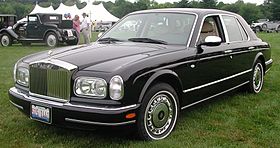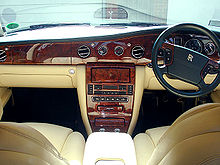Rolls-Royce Silver Seraph
This article needs additional citations for verification. (October 2018) (Learn how and when to remove this template message) |
| Rolls-Royce Silver Seraph | |
|---|---|
 | |
| Overview | |
| Manufacturer | Rolls-Royce Motors |
| Production | 1998–2002 |
| Assembly | United Kingdom: Crewe, England |
| Designer | Steve Harper under Graham Hull |
| Body and chassis | |
| Class | Full-size luxury car (F) |
| Body style | 4-door saloon |
| Layout | Front-engine, rear-wheel-drive |
| Related | Rolls Royce Ghost |
| Powertrain | |
| Engine | 5.4 L BMW M73 V12 |
| Transmission | 5-speed ZF 5HP30 automatic |
| Dimensions | |
| Wheelbase | 3,117 mm (122.7 in) |
| Length | 5,390 mm (212.2 in) |
| Width |
|
| Height | 1,514 mm (59.6 in) |
| Chronology | |
| Predecessor | Rolls-Royce Silver Spirit |
| Successor | Rolls Royce Ghost |
The Rolls-Royce Silver Seraph is a large luxury automobile produced by Rolls-Royce Motors from 1998 to 2002. First unveiled on 3 March 1998 at the Geneva Motor Show, it replaced the Silver Spur, which ended production in 1997. Silver Seraph production was discontinued when the license to use the Rolls-Royce marque was sold to BMW, which began manufacture of an unrelated line of vehicles under a new corporation, Rolls-Royce Motor Cars.
Development[edit]
Development of the Silver Seraph began in the late 1980s, with design work commencing in October 1990. By April 1991, the conceptual design was frozen and approved by the management in June 1991.[1] After several refinements were made, the definitive design was reached in 1994. On 28 July 1995 design patents were filed for both the Rolls-Royce Silver Seraph[2] and Bentley Arnage[3] utilizing production design prototypes as representations. Development concluded after nearly a decade in late 1997, with pilot production models being produced into early 1998 bearing R396 DTU registration plates.
Description[edit]
Aside from the radiator grille, badges and wheels, the Seraph was externally identical to the contemporary Bentley Arnage, sharing both its platform and body shell. It was powered by a BMW M73 5.4 L aluminium alloy V12 engine coupled to a 5-speed automatic transmission, making it the first twelve-cylinder Rolls-Royce since the 1939 Phantom III.
The body was 65 percent stiffer than that of its predecessor. Standard electronics included digital engine management, adaptive ride control and anti-lock brakes. The exterior was available in one and two-tone finishes.
Inside, the Rolls-Royce Silver Seraph and the Bentley Arnage were similar yet distinct. The Seraph's gear selector was column-mounted, and gauges followed a traditional Rolls-Royce layout. In both cars, the seats and dashboard were upholstered in Connolly Leather, with dashboard trim and folding picnic trays for rear passengers faced with glossy burl walnut veneer.
The Seraph was known for its relatively limited acceleration and comfortable handling, in comparison to the Arnage, which had a twin turbocharged V8 of its own design and firmer suspension. However, the Seraph still had a top speed of 225 km/h or 140 mph.
The RAC gave the car a rating of 7.6/10, stating "The Silver Seraph marks a new start for Rolls-Royce in their quest to once more be recognised as manufacturers of the world's best cars. And it's quite a credible effort.[4]
Production[edit]
All Seraphs were hand-built at the Rolls-Royce factory in Crewe, England. The car had a base price of £155,175 in the UK and $220,695 in the US. It was second in cost and exclusivity only to the Rolls-Royce Corniche.
A total of 1,570 Silver Seraphs were produced before manufacture ceased in 2002.
Park Ward model[edit]
An extended wheelbase 5-passenger version of the Silver Seraph called the Park Ward debuted at the 2000 Geneva Motor Show. Introduced for the 2001 model year, it had 250 mm (9.8 in) added to the size of the doors (mostly the rear), resulting in more leg room for passengers. The model was discontinued after 2002, with a total of 127 having been produced.[5]
References[edit]
- ^ "SHADO - Car Design Consultancy". shado.co.uk.
- ^ "Automobile".
- ^ "Automobile".
- ^ "Rolls-Royce Silver Seraph (1998-2005)". RAC. Archived from the original on 2 October 2011. Retrieved 17 August 2011.
- ^ "Rolls-Royce Park Ward". www.rrab.com. Retrieved 9 March 2019.
External links[edit]
| Wikimedia Commons has media related to Rolls-Royce Silver Seraph. |
| hide Rolls-Royce Motor Cars timeline
| |||||||||||||||||||||||||||||||
|---|---|---|---|---|---|---|---|---|---|---|---|---|---|---|---|---|---|---|---|---|---|---|---|---|---|---|---|---|---|---|---|
| Type | 1900s | 1910s | 1920s | 1930s | 1940s | 1950s | 1960s | 1970s | 1980s | 1990s | 2000s | 2010s | |||||||||||||||||||
| Ownership | Independent | Vickers plc | VW Group | BMW | |||||||||||||||||||||||||||
| Luxury car | 10 hp 15 hp |
V-8 20 hp |
Twenty | 20/25 | 25/30 | Wraith | World War II | Silver Dawn | Silver Cloud | Silver Shadow | Silver Spirit/Dawn | Ghost | |||||||||||||||||||
| Ultra-luxury car | 30 hp | 40/50 hp (Silver Ghost) | Phantom I/II/III | Silver Wraith | Silver Wraith II | Silver Spur | Silver Seraph | Ghost Extended Wheelbase | |||||||||||||||||||||||
| Phantom IV | Phantom V | Phantom VI | Touring Limousine | Park Ward | Phantom VII/VIII | ||||||||||||||||||||||||||
| Convertible | Dawn | ||||||||||||||||||||||||||||||
| Corniche/II/III/IV | Corniche V | Phantom Drophead | |||||||||||||||||||||||||||||
| Coupé | Corniche & Camargue | Silver Spirit Hooper 2 Door | Wraith | ||||||||||||||||||||||||||||
| Phantom Coupé | |||||||||||||||||||||||||||||||
| SUV | Cullinan | ||||||||||||||||||||||||||||||

